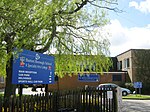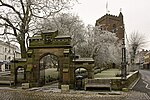The Puleston Cross is a Butter cross in the market town of Newport, in the Telford and Wrekin district, in the ceremonial county of Shropshire, England.
The Cross sits in Middle Row, formerly Rotten Row, and denotes the market place. The cross was built in the early 14th century and was moved to this position in 1633 after the new market hall was built by William Adams.
The Butter Cross
The Market or "Butter" Cross of which this is the shaft and base,
was originally set up c.1280 in memory of Roger de Pyvelesdon,
and hence is also known as "The Puleston Cross".
It was probably mutilated during the Civil War.
The cross is protected as a monument of National Importance
under the Ancient Monuments Act 1913–1953.
The cross was set up in memory of Sir Roger de Pyvelesdon who died in 1272, in Shropshire. This is confirmed in a deed dated 1285, signed by his son and namesake Sir Roger de Puleston, which includes these words: the cross set up for the soul of Roger de Pyvelesdon who died in 1272.
It has remained in its current position since the 13th century, and the Butter Cross (market) was built around it by Richard Barnefield in 1632. Some records indicate that it was rebuilt by Thomas Talbott in 1665. The market was demolished in 1866. It was taken down as there was no further use for it when the new market hall was built.
The Market cross was spared demolition and given railings to protect the cross from damage; these have since been taken down.
The market cross consists of five steep octagonal steps leading to the remains of a square-sectioned fluted shaft made from Sandstone and is overall 500cm high.











